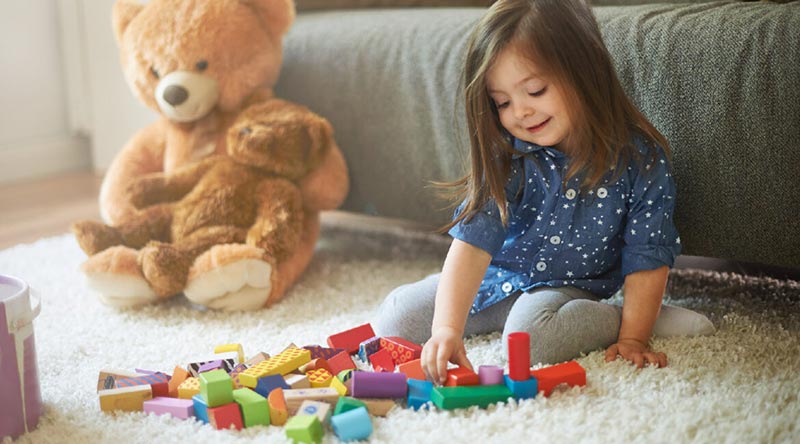At Right Start Inc we understand that children with Autism Spectrum Disorder (ASD) often have a difficult time developing communication and social skills. It may also be a challenge for children to process sensory information.
Learning these skills is often much more challenging for children with ASD than other children their age, so the same teaching methods and activities don’t always work. That’s why it’s important to establish activities specifically for your child with autism spectrum disorder and help them learn, grow, and have fun in a comfortable way.
Here are some activity ideas for children diagnosed with autism:
-
Create a safe sensory time-out area
The area should be in a place in which your child feels safe and more relaxed, so avoid creating it in the center of the family’s home. Encourage your child to work with you and give them choices of materials that would be included in the sensory area.
If you are feeling ambitious, you could create your child an entire sensory room!
- Use a large cardboard box from an appliance and tape the edges with colored duct tape to prevent paper cuts.
- Hang a hula-hoop decorated with ribbons, so they cascade down. This is an awesome visual resembling a colorful waterfall which is awesome for tactile play too!
- Even a closet or corner can work, it’s what’s inside that’s important.
- Include a weighted blanket and lap pad.
- Add a CD player or music your child finds calming.
- Make sure your child has fidgeted items to keep hands busy.
-
Make an obstacle course
Use anything you can find. Taped lines are wonderful for ‘pretend’ balance beams. Hula-hoops, bean bag tossing, jump ropes can all be included. Walking like animals is always fun and builds awesome gross motor skills.
- Hop like a frog
- Gallop like a horse
- Slither like a snake
- Crawl like a puppy
- Wiggle like a worm
- Jump like a kangaroo
- Walk like a crab
- Prance like a unicorn
-
Create sensory bins full of fun items
It’s so easy to get stuck using only rice or grain. To prevent a huge mess, introduce play on top of a shower curtain.
- Aquarium gravel comes in awesome colors
- Easter grass
- Straws cut up into pieces… In fact, let kids cut the straws to build fine motor skills
- Feathers
- Moon dough
- Tissue paper pieces
- Ribbon
- Buttons and beads
- Dirt and sand
Here are some sensory and communication/social skill ideas for activities for children with autism:
- Sensory Activities – Sensory activities help children with Autism Spectrum Disorder process different senses and become more adjusted to experiencing them. Many of the activities also help build fine motor skills.
- Sensory bottles – Fill a plastic water bottle with water, glitter, food coloring, and other items like marbles and buttons to create a fun way for your child to engage and stay focused.
- Coin rubbing – Put coins down on the table and let your child use crayons to rub/trace over them on a piece of paper.
- Making edible jewelry – Use thin snacks like licorice to string different foods into a fun and fashionable necklace or bracelet, helping build motor skills.
- Sensory collage/bins/table – Use items with different textures, like straws, ribbon, and rocks to educate your child on different feels and colors.
- Ice painting – Fill an ice tray with different colored paints, place a popsicle stick in each compartment, and freeze. Once frozen, let your child get creative by drizzling the paint over paper.
- Smelling game – Place different items like coffee, flowers, or soap in empty jars, then cover them with a thin cloth and secure with a rubber band. Let your child smell each jar and try to determine the different scents.
Communication/Social Skills: Other activities help children with ASD learn how to communicate and develop social skills, like concentration and play skills.
- Matching halves – Create a pattern on a pair of popsicle sticks, then separate the sticks and let your child figure out the puzzle.
- Musical freeze – Let your child get active and dance to music, but then work on his or her self-control by having them freeze once the music stops.
- Paint sample storytelling – Let your child use paint samples (and their interesting names) as inspiration for their stories.
- Pool noodles – Use pool noodles to make lightsabers, cut them up and create building blocks, use them to create alphabet blocks, make obstacle courses, use them to funnel water, string them together, or even create boats!
- Bubbles – Get outside and let your child play with bubbles, popping as many as they’d like. Then, help them learn self-control by only letting them pop bubbles when you say so.
Children enjoy diving hands first into play experiences. Completing the tasks of building blocks, working a puzzle, and drawing pictures will yield skills that the child will use throughout their lifetime.
Remember that children are wired to use their senses to develop skills during play.

